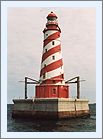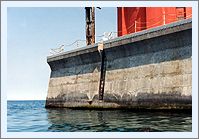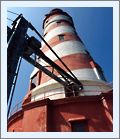|
Historical
Information

Located approximately 20 miles east of Mackinac Point and 2.6
miles northwest of Waugoshance Island, the
shallows around White Shoal had long presented a hazard for vessels
entering the
Straits from the either the North Shore or the Manitou Passage.
Lying in an east/west orientation, and almost two miles long, the shoal
was so shallow that its west end broke the water's surface.
With the dramatic increase in vessel
traffic in the late 1880's, the Lighthouse Board specifically identified
White Shoal, Simmons Reef and Gray's Reef as three Straits-area
navigational hazards requiring immediate demarcation. While the
construction of permanent navigational aids was preferred, it was soon
evident that the anchoring of lightships over the hazards represented a
significantly more expeditious and far more cost effective solution.
Bids were submitted to a number of
shipbuilders, with the $60,000 contract for the construction of three
sister vessels awarded to the Blythe Craig Shipbuilding Co of Toledo
Ohio. Wood framed and planked, the three identical 130 gross tonnage
vessels were built with a length of almost 103 feet, a 20' beam, and a
draft of 7' 5". Equipped with single-cylinder non-condensing steam
engines, they were the first U.S. light vessels to be outfitted with
self-propelling engines. Each vessel displayed a cluster of three
oil-burning lens lanterns hoisted on the masthead, and a six-inch steam
whistle and a hand operated bell for use during periods of decreased
visibility.
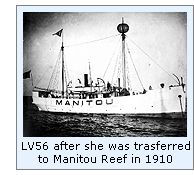 Work on the vessels was completed on
September 15, 1891, whereupon they were turned over to the Lighthouse
Establishment, and officially designated as LV55, LV56 and LV57. Upon
receipt of the vessels, the Lighthouse Establishment conducted a series
of sea trials through October 6. After a number of minor modifications,
the three vessels departed the Lighthouse Depot in Detroit on October
19, reaching Port Huron that same evening, where they were met by the
lighthouse tender Dahlia, who began towing them north along the western
shore of Lake Huron. LV56 was finally delivered on station at White
Shoal on October 24, and was secured to the five-ton sinker and 15
fathoms of 2-inch chain, which had previously been placed on the shoal
in preparation for the vessel's arrival. Work on the vessels was completed on
September 15, 1891, whereupon they were turned over to the Lighthouse
Establishment, and officially designated as LV55, LV56 and LV57. Upon
receipt of the vessels, the Lighthouse Establishment conducted a series
of sea trials through October 6. After a number of minor modifications,
the three vessels departed the Lighthouse Depot in Detroit on October
19, reaching Port Huron that same evening, where they were met by the
lighthouse tender Dahlia, who began towing them north along the western
shore of Lake Huron. LV56 was finally delivered on station at White
Shoal on October 24, and was secured to the five-ton sinker and 15
fathoms of 2-inch chain, which had previously been placed on the shoal
in preparation for the vessel's arrival.
Life onboard the vessel was evidently
not too agreeable to the first crew of the LV56, since without orders
they abandoned their station during a storm on November 17, and put into
their winter quarters in Cheboygan. The entire crew was immediately
discharged for dereliction of duty, and a replacement crew quickly
selected. The tender Dahlia again towed LV56 back to her station on
November 22, where she remained until close of the shipping season, when
she received orders to return to her Cheboygan winter quarters. With the
exception of her annual winter lay-ups from late December through
ice-out in April or May, LV56 continued her faithful service at White
Shoal for the following nineteen years.
Largely as a result of repeated
difficulties getting the lightship on and off station at the beginning
and end of each navigation season, in 1906 the Lighthouse Board
petitioned the U.S. Congress for the funds to construct a permanent
light station on the shoal. Congress responded favorably on March 4,
1907 with an appropriation of $250,000 for the project, and with Major
William V. Judson U.S.A.C.E, and lighthouse engineer for the Michigan
District in charge of both the design and construction, work began at
White Shoal the following year.
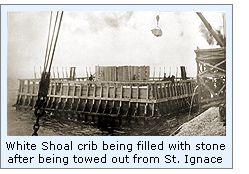 Spring of 1908 saw work begin on the
White Shoal light on two separate fronts. While a crew at the site leveled a one hundred and two-foot square area on the shoal through the
addition and careful placement of loads of stone, a second crew worked
on building a timber crib on shore at St. Ignace. Seventy-two feet
square and eighteen and a half feet high, the huge crib contained
400,000 square feet of lumber, and on completion was slowly towed
out to the shoal and centered over the leveled lake bottom. Once in
location, the crib was filled with 4,000 tons of stone until it sank to a point at
which its' uppermost surface was level and two feet below the water's
surface. Spring of 1908 saw work begin on the
White Shoal light on two separate fronts. While a crew at the site leveled a one hundred and two-foot square area on the shoal through the
addition and careful placement of loads of stone, a second crew worked
on building a timber crib on shore at St. Ignace. Seventy-two feet
square and eighteen and a half feet high, the huge crib contained
400,000 square feet of lumber, and on completion was slowly towed
out to the shoal and centered over the leveled lake bottom. Once in
location, the crib was filled with 4,000 tons of stone until it sank to a point at
which its' uppermost surface was level and two feet below the water's
surface.
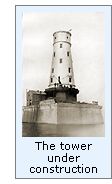 On top of this crib, a seventy-foot
square stone block base was constructed to a total height of four
feet, with the remainder of the pier being of poured concrete atop the
block base. With the base complete, an acetylene-powered lens lantern
was installed atop a temporary steel skeletal tower on December 5th, and
with the onset of winter storms, work at the
shoal ended for the season. On top of this crib, a seventy-foot
square stone block base was constructed to a total height of four
feet, with the remainder of the pier being of poured concrete atop the
block base. With the base complete, an acetylene-powered lens lantern
was installed atop a temporary steel skeletal tower on December 5th, and
with the onset of winter storms, work at the
shoal ended for the season.
Work crews returned the following year
to find the crib and pier in excellent condition, and the work effort
turned toward construction of the tower itself. Work on this second year
started with the erection of a skeletal steel framework that had been
prefabricated offsite over the winter, and disassembled for shipment to
the shoal. This framework was then lined with bricks and covered with a
skin of terra cotta blocks. With an outside diameter of forty-two feet
at the base, the tower tapered gracefully to a diameter of twenty feet
at its' uppermost below the gallery.
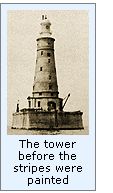 As work on the tower continued,
the nine decks took shape within the tower. The first deck mechanical
room housed the oil engine powered fog signal, heating plant, and storage for the
station's powerboat. The second deck housed a tool room, bathroom and food
storage area. A kitchen, living room and one bedroom made up the third
deck, with two more bedrooms and a toilet located on the fourth. A
living area and another bedroom were found on the fifth deck, and the
sixth and seventh contained a single open room on each. The service room
made up the eighth level, and the watchroom topped the living quarters
on the ninth. As work on the tower continued,
the nine decks took shape within the tower. The first deck mechanical
room housed the oil engine powered fog signal, heating plant, and storage for the
station's powerboat. The second deck housed a tool room, bathroom and food
storage area. A kitchen, living room and one bedroom made up the third
deck, with two more bedrooms and a toilet located on the fourth. A
living area and another bedroom were found on the fifth deck, and the
sixth and seventh contained a single open room on each. The service room
made up the eighth level, and the watchroom topped the living quarters
on the ninth.
Work at the station continued through
the end of the shipping season in 1909, when once again the station was
abandoned until work could resume with the receding ice in the spring of
1910.
Work
crews returned to the station on the opening of the 1910 navigation
season, and the the tower was
capped with a circular watch room and lantern room, both of twelve and a
half feet in diameter. The aluminum lantern featured helical astragals,
which the Board had recently begun incorporating in new construction,
since it was believed that they offered less light interference than the
vertical astragals that had been prevalently used for the past sixty
years. As construction of the tower wound to completion, the entire
structure from the crib deck to lantern ventilator was given a coat of
bright white paint, designed to improves the structure's visibility
during daylight hours.
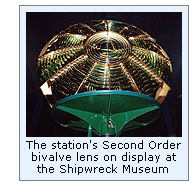 After
the District Lampist arrived at the site and installed
the massive Second Order Fresnel lens
the new light was exhibited for the first time on the night of September
1, 1910. Manufactured by Barbier, Benard
& Turenne of Paris, the lens was built in a two-sided design known
as a bi-valve configuration, with each side featuring 7 refracting and
15 reflecting prisms. In order to allow the heavy lens assembly to rotate with the
minimum amount of friction, the entire structure was floated in a
trough of mercury, and rotated by a clockwork mechanism, which was
powered by hanging weights. Located at a focal plane of 125 feet, the
lens rotated once every 32 seconds. Its 55mm double tank incandescent
oil vapor lamp was thus magnified to 1,200,000 candlepower, making the
light visible for a remarkable distance of 28 miles in clear weather
conditions. After
the District Lampist arrived at the site and installed
the massive Second Order Fresnel lens
the new light was exhibited for the first time on the night of September
1, 1910. Manufactured by Barbier, Benard
& Turenne of Paris, the lens was built in a two-sided design known
as a bi-valve configuration, with each side featuring 7 refracting and
15 reflecting prisms. In order to allow the heavy lens assembly to rotate with the
minimum amount of friction, the entire structure was floated in a
trough of mercury, and rotated by a clockwork mechanism, which was
powered by hanging weights. Located at a focal plane of 125 feet, the
lens rotated once every 32 seconds. Its 55mm double tank incandescent
oil vapor lamp was thus magnified to 1,200,000 candlepower, making the
light visible for a remarkable distance of 28 miles in clear weather
conditions.
After activation of the new light station, LV56 was no longer needed at White Shoal, and the vessel was reassigned
to duty at North Manitou Shoal, where she stayed through every shipping
season until 1927 when she was once again reassigned to Gray's Reef. She
was retired from service in 1928, and was sold into private ownership on
December 20 of that same year.
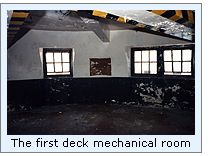 A
submarine bell located in 70 feet of water approximately 3/4 of a mile
from the crib was installed in 1911, and placed into operation on
September 20. Powered by a submarine electrical cable from the station,
the sound transmission property of the water allowed the bell to be
heard through the hulls of approaching vessels long before the fog
signals could be heard in thick weather. A
submarine bell located in 70 feet of water approximately 3/4 of a mile
from the crib was installed in 1911, and placed into operation on
September 20. Powered by a submarine electrical cable from the station,
the sound transmission property of the water allowed the bell to be
heard through the hulls of approaching vessels long before the fog
signals could be heard in thick weather.
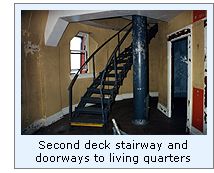 1913
saw the installation of a pair of compressed air operated deck cranes for unloading supplies, and for raising and
lowering the keepers boat which was used for both bringing supplies
and taking shore leave. To further improve the station's efficacy during
thick weather, the six-inch whistles were removed and replaced with
10-inch whistles on April 22, 1914. Proving to be less successful as
originally intended, the submarine bell was permanently discontinued at
the end of the 1914 season of navigation. 1913
saw the installation of a pair of compressed air operated deck cranes for unloading supplies, and for raising and
lowering the keepers boat which was used for both bringing supplies
and taking shore leave. To further improve the station's efficacy during
thick weather, the six-inch whistles were removed and replaced with
10-inch whistles on April 22, 1914. Proving to be less successful as
originally intended, the submarine bell was permanently discontinued at
the end of the 1914 season of navigation.
In 1930, twin
diesel engine-powered generators were installed in the mechanical
room, providing electrical power to both the living quarters and the
light, which a resulting increase in output to 3,000,000 candlepower.
With its multiple windows an all sides
of the tower, duty at White shoal was surprisingly comfortable during the summer,
since there was always good cross ventilation. In the Spring and early
winter, the oil engines furnished steam heat
to radiators located on all floors, keeping the temperature comfortable
year-round. After the Coast Guard's assumption of responsibility for the nation's
aids to navigation in 1939, four-man crews were assigned at the station.
Working a 14-days on and 7-days schedule, three seamen were always on
board while the fourth man was on Liberty.
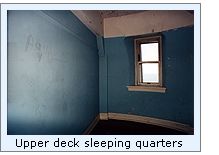 The station was automated in 1976 with
the installation of a 12-volt DC solar-powered 190mm Tidelands Signal acrylic lens. The Second
Order Fresnel was dismantled in 1983, and relocated to the Shipwreck
Museum at Whitefish Point Light Station where it is
proudly displayed to this
day. The station was automated in 1976 with
the installation of a 12-volt DC solar-powered 190mm Tidelands Signal acrylic lens. The Second
Order Fresnel was dismantled in 1983, and relocated to the Shipwreck
Museum at Whitefish Point Light Station where it is
proudly displayed to this
day.
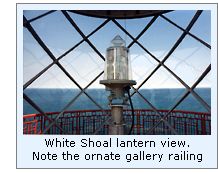 A Coast Guard crew arrived at the
station in 1990, and the tower was repainted with its' current
"candy cane" red and white spiral daymark. With the
application of this daymark, White Shoal stands as the only tower on all
of the Great Lakes to feature such a diagonally banded paint scheme. A Coast Guard crew arrived at the
station in 1990, and the tower was repainted with its' current
"candy cane" red and white spiral daymark. With the
application of this daymark, White Shoal stands as the only tower on all
of the Great Lakes to feature such a diagonally banded paint scheme.
As of this writing, we have been unable
to determine the fate of LV56 after she was sold into private ownership
in 1928. If any of our visitors have definitive information as to the
history of this vessel after that date, we would appreciate hearing from
you.

Keepers of this
Light

Click Here
to see a complete listing of
all White Shoal Light keepers compiled by Phyllis L. Tag of Great Lakes
Lighthouse Research.

Seeing
this Light

Sheplers
Ferry Service out of Mackinaw City offers a number of lighthouse cruises
during the summer season. Their "Westward Tour" includes
passes by White Shoal, Grays Reef, Waugoshance and St. Helena Island.
For schedules and rates for this tour, visit their website at: www.sheplerswww.com
or contact them at:
PO Box 250
Mackinaw City, MI 49701
Phone (800) 828-6157

Reference
Sources

Inventory
of Historic Light Stations, National Parks Service, 1994
USCG Historians office, Photographic
archives.
Annual Reports of the Lighthouse Board, various, 1867 - 1909
Annual Reports of the Lighthouse Service, 1910 - 1913
Annual Reports of the Lake Carriers Association, 1908 - 1938
Email correspondence with Timothy Larson and Art Miller who both
served at the station with USCG.
Lightships and Lightship Stations of the United States Government,
Willard Flint, 1989
Great Lakes Coast Pilot, NOAA, 2000
Keeper listings for this light appear
courtesy of Great
Lakes Lighthouse Research
|
